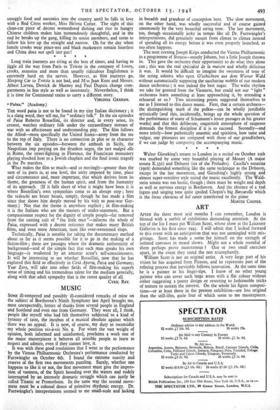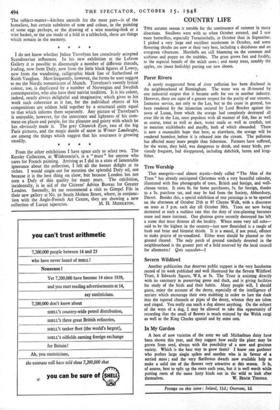ART
AFTER the three most arid months I can remember, London is blessed with a surfeit of exhibitions demanding attention. At the top of the list I must put William Scott, whose show at the Leicester Galleries is his first since 1942. I will admit that I looked forward to this event with an anticipation that was not unmingled with mis- givings. Scott has made a name for himself on the strength of isolated canvases in mixed shows. Might not a whole roomful of them perhaps prove monotonous ? One or two small exercises apart, in the event they stand the test triumphantly. William Scott is not an original artist. A very large part of his vision he has acquired from Picasso, and he represents part of the refining process that inevitably follows innovation. At the same time he is a painter to his finger-tips. I know of no other young painter who can cover such large areas with a flat colour without either suggesting a poster design or resorting to fashionable tricks of texture to sustain the interest. On the whole his figure composi- tions—or at least those in the present exhibition—are less original than the still-lifes, quite four of which seem to me masterpieces.
The subject-matter—kitchen utensils for the most part—is of the homeliest, but certain subtleties of tone and colour, in the painting of some eggs perhaps, or the drawing of a wire toasting-fork or a wire basket, or the use made of a fold in a tablecloth, these are things which remain in the memory.
I do not know whether Julian Trevelyan has consciously accepted Scandinavian influences. In his new exhibition at the Lefevre Gallery it is possible to disentangle a number of different threads, leading, now from Dufy, now from the little black figures of Lowry, now from the wandering, calligraphic black line of Sutherland or Keith Vaughan. Most frequently, however, the forms he uses suggest to me the Nordic romanticism of Munch. Trevelyan's sweetly lyrical colour, too, is duplicated by a number of -Norwegian and Swedish contemporaries, who also have their naivist tradition. It is his colour, indeed, nearly always delightful and imaginative' which gives to his work such coherence as it has, for the individual objects of his compositions are seldom held together by a structural unity equal to that which informs them separately. Any picture of Trevelyan's is enjoyable, however, for the innocence and lightness of his com- ment on places and people, for the pleasure and gaiety with which he has obviously made it. The grey Chiswick Eyot, two of the big Paris pictures, and the magic dazzle of snow in Winter Landscape, are among the things which suggest that his assurance is growing
steadily. * * * *
From the other exhibitions I have space only to select two. The Kessler Collection, at Wildenstein's, is a " must " for anyone who cares for French painting. Arriving as I did in a state of lamentable ignorance about the collection, I felt all the keener delight at its riches. I would single out for mention the splendid Dufy oil, not because it is the best thing on show, but because London has not seen a Dufy of this quality for many years. The exhibition, incidentally, is in aid of the Citizens' Advice Bureau for Greater London. Secondly, let me recommend a visit to Gimpel Fils in their new gallery at No. 5o South Molton Street, where, in conjunc- tion with the Anglo-French Art Centre, they are showing a new



































 Previous page
Previous page